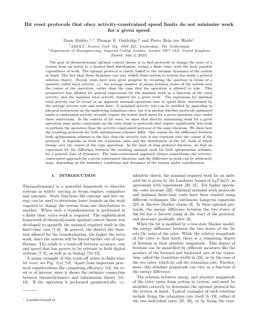2025-04-29
Bit reset protocols that obey activity-constrained speed limits do not minimize work for a given speed
Publication
Publication
Phys. Rev. E , Volume 111 - Issue 4 p. 044141: 1- 15
The goal of thermodynamic optimal control theory is to find protocols to change the state of a system from an initial to a desired final distribution, within a finite time, with the least possible expenditure of work. The optimal protocol is closely linked to the intrinsic dynamics of the system at hand. The fact that these dynamics can vary widely from system to system has made a general solution elusive. Recent years have seen great progress by recasting the question in terms of a quantity called total activity, i.e., the average number of jumps between states of the system over the course of the operation, rather than the time that the operation is allowed to take. This perspective has allowed for general expressions for the minimal work as a function of the total activity, and the minimal total activity required for a given work. The expression for minimal total activity can be recast as an apparent minimal operation time or speed limit, determined by the average activity rate and work done. A maximal activity rate can be justified by appealing to physical restrictions on the underlying transition rates, but it is unclear whether protocols optimized under a constrained activity actually require the lowest work input for a given operation time under these restrictions. In the context of bit reset, we show that directly minimizing work for a given operation time under constraints on the rates leads to protocols that require significantly less work to perform the operation than the activity-constrained protocol of the same duration. We show how the resulting protocols for both optimization schemes differ. One reason for the difference between both optimization schemes is the fact that the activity rate is not constant over the course of the protocol: it depends on both the transition rates and the distribution of the bit, both of which change over the course of the copy operation. In the limit of long protocol duration, we find an expression for the difference between the resulting minimal work for both optimization schemes, for a general class of dynamics. The time-constrained approach always outperforms the activity-constrained approach for a given constrained duration, and the difference in work can be arbitrarily large, depending on the boundary conditions and dynamics of the system under consideration.
| Additional Metadata | |
|---|---|
| American Physical Society (APS) | |
| Netherlands Organisation for Scientific Research (NWO) , European Research Council (ERC) | |
| doi.org/10.1103/PhysRevE.111.044141 | |
| Phys. Rev. E | |
| Organisation | Biochemical Networks |
|
Mulder, D., Ouldridge, T., & ten Wolde, P. R. (2025). Bit reset protocols that obey activity-constrained speed limits do not minimize work for a given speed. Phys. Rev. E, 111(4), 044141: 1–15. doi:10.1103/PhysRevE.111.044141 |
|
